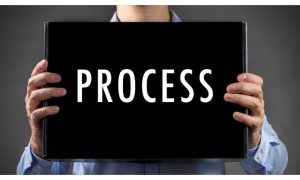Loan origination is the process of applying for and obtaining a loan, including all the steps and activities that are involved in evaluating, approving, and disbursing the loan.
This process includes activities such as evaluating a borrower’s creditworthiness, income, and other financial information; determining the loan amount, interest rate, and other loan terms; and preparing and submitting the loan application. It also includes various other steps such as underwriting, documentation, and funding. The lender typically charges a loan origination fee, which is around 1% of the loan amount, to cover the cost of the work involved in the origination process.
The Loan Origination Process
Loan origination is a 7-step process that all individuals must undergo to acquire a mortgage or home loan. This term also extends to other forms of amortized personal loans.
In finance, origination is frequently a protracted procedure overseen by the Federal Deposit Insurance Corporation (FDIC) to ensure compliance with Title XIV of the Dodd-Frank Wall Street Reform and Consumer Protection Act. Typically, the loan origination process includes the following 7 stages:
Stage 1: Pre-qualification
During pre-qualification, the borrower furnishes the lender with details regarding their income, assets, and credit history. Typically, the borrower provides the following information:
- Income: Including salary, wages, bonuses, and other income sources.
- Assets: Such as bank account balances, investments, and other assets.
- Liabilities: Covering credit card balances, car loans, and other debts.
- Credit history: Comprising credit score and credit report.
Utilizing their internal underwriting guidelines and loan program requirements, the lender evaluates this information to gauge the borrower’s likelihood of qualifying for a loan and to determine suitable loan terms, including the interest rate. It’s essential to recognize that pre-qualification does not ensure loan approval, as the lender must verify all provided information before granting approval. This stage aids the lender in assessing the borrower’s eligibility for a loan and estimating the loan amount and interest rate.
Stage 2: Application
In this stage, the borrower forwards a loan application to the lender. The application process typically encompasses the following steps:
- Application Form: The borrower fills out a loan application form containing details such as their name, address, income, employment history, assets, liabilities, and credit history.
- Supporting Documents: Alongside the application, the borrower provides supporting documents like pay stubs, W-2 forms, tax returns, bank statements, and proof of insurance. Depending on the loan type and the borrower’s credit history, additional documentation may be necessary.
- Credit Report: The lender procures a credit report to verify the borrower’s credit score and credit history.
Stage 3: Processing
Processing involves the administrative tasks necessary to prepare a loan application for underwriter review. This encompasses collecting and validating borrower information such as credit history, income, assets, and liabilities. Additionally, it entails compiling required documentation like pay stubs, tax returns, and insurance proof. The processor ensures all information and documents are complete and accurate before forwarding the application to the underwriter.
Stage 4: Underwriting
Underwriting entails assessing the borrower’s creditworthiness, income, assets, liabilities, and collateral securing the loan. The underwriter verifies application details and may request additional documentation. The objective is to gauge the borrower’s repayment capability and establish terms to mitigate default risk.
Stage 5: Approval
Approval signifies the lender’s decision to grant the loan. Upon approval, the lender furnishes the borrower with a loan estimate, outlining terms such as interest rate, monthly payments, and associated fees.
Stage 6: Closing
Closing is the final step where the borrower agrees to loan terms, and the lender disburses funds. During this phase, the borrower reviews and signs loan documents, including promissory notes and mortgages, while the closing agent collects any due fees. Once all documents are signed, and funds disbursed, the loan is considered closed.
Stage 7: Servicing
The lender manages loan servicing tasks, encompassing payment collection, escrow management, and enforcement of loan terms.
Loan Origination Automation
Manual and paper-based underwriting processes are often characterized by inconsistency, lack of accountability, and inaccuracy, as well as being time-consuming.
One prevalent form of loan origination automation is through online applications and portals, where borrowers can digitally apply for loans and submit documentation. Another example is automated underwriting systems, capable of analyzing borrower information and making loan decisions based on predefined criteria. Some lenders leverage artificial intelligence and machine learning to enhance the accuracy and efficiency of underwriting processes. For instance, Quicken Loans implemented an end-to-end digital mortgage process using a digital mortgage platform, allowing borrowers to apply, upload documentation, and receive loan approval online. This initiative has significantly improved customer experience and reduced loan closing time.
There are numerous advantages to loan origination automation, including:
- Enhanced Efficiency: Automated systems swiftly and accurately collect and verify borrower information, reducing the need for manual data entry and minimizing error risks. They can also automate underwriting processes, enabling lenders to promptly assess loan applications based on various factors like creditworthiness, income, and collateral.
- Improved Accuracy: Automation in banking loan origination systems fosters more consistent and precise data handling. Moreover, the integration of artificial intelligence and machine learning enhances underwriting accuracy and other origination processes.
- Cost Reduction: Automation diminishes costs by eliminating manual labor and reducing reliance on paper-based documentation, ultimately bolstering lender profitability.
- Enhanced Customer Experience: Automation streamlines and enhances the loan origination journey, making it more efficient and convenient for customers. For instance, digital mortgage platforms enable borrowers to apply, submit documentation, and receive approval online.
- Regulatory Compliance: Automated origination systems ensure regulatory compliance by delivering consistent and accurate data and automating compliance checks.
- Scalability: Automation empowers lenders to manage larger volumes of loan applications, catering to high-demand scenarios or rapid business expansion.
Choosing a Tool for Loan Origination Automation
When selecting a technology for automating loan origination, it’s vital to have a clear understanding of which aspects of the process can be automated. Although automating the entire process is feasible, implementing an end-to-end solution requires time. Technologies like RPA, OCR, and AI can contribute to business process automation, but identifying the most suitable technology for a specific use case is essential for successful deployment.
When considering an automation tool for loan origination, several key factors should be taken into account:
- Functionality: Ensure the tool can automate the specific tasks and processes inherent in your loan origination process, encompassing application and document collection, underwriting, approval, and closing.
- Integration: Verify that the tool can seamlessly integrate with your existing systems and workflows, aligning with your current process.
- Scalability: Confirm that the tool can handle the volume of loan applications your organization receives and can scale alongside your business growth.
- Security: Prioritize tools with robust security features to safeguard sensitive borrower information and comply with regulations and data privacy laws.
- Reporting and Analytics: Seek a tool that offers comprehensive reporting and analytics capabilities to monitor performance, pinpoint areas for enhancement, and measure outcomes.
- Cost: Ensure the tool is cost-effective and delivers a satisfactory return on investment.
- Support: Choose a tool with a dependable and responsive support team capable of assisting with setup, implementation, and ongoing maintenance.
- Compliance: Ensure the tool can adhere to regulations and industry standards, guaranteeing compliance throughout the loan origination process.
Takeaway
Automation technology has significantly enhanced efficiency across various industries globally. However, the process of initiating small business and commercial loans has seen minimal evolution over the years. Nonetheless, there’s a burgeoning trend as traditional lenders increasingly embrace automation in their loan origination procedures. This shift stems from several factors, including competition from tech-driven rivals, the pursuit of heightened efficiency and productivity, an imperative to enhance customer service, cost-effectiveness, and compliance with stringent regulatory requirements. Many lenders are propelled to adopt technological solutions to bolster data management, attain more precise business insights, and exercise better control.
The move towards automation in commercial lending isn’t aimed at supplanting human intelligence. Rather, it seeks to retain talent while empowering bankers to concentrate on critical tasks such as risk assessment and nurturing customer relationships, rather than mundane administrative duties.













